Developer / Publisher – Xlab Digital LLC / Andromeda Entertainment
Price – US $14.99 / CAN 16.99 / EU €14.99 / UK £12.99
Release Date – October 27th, 2022
Input – 2 x Motion Controllers
Play Area – Seated, Standing
Store Links – Meta, Steam
Reviewed on – Quest 2, Quest 2 w/ Link
The year is 2232 A.D. and the crew of the Avalon has crash landed on the planet Akris during their investigation into the status of a drone ship carrying AI terraformer bots which has lost contact. As First Officer Graves, it’s up to you to protect the lives of the surviving crew, as well as defend and secure all resources from the onslaught of the out-of-control terraformer bots.Iron Guard is a room-scale tower defense game that has you building, upgrading, harvesting and shooting your way to victory against an army of rogue robots. This is a single-player experience only that can be played offline.
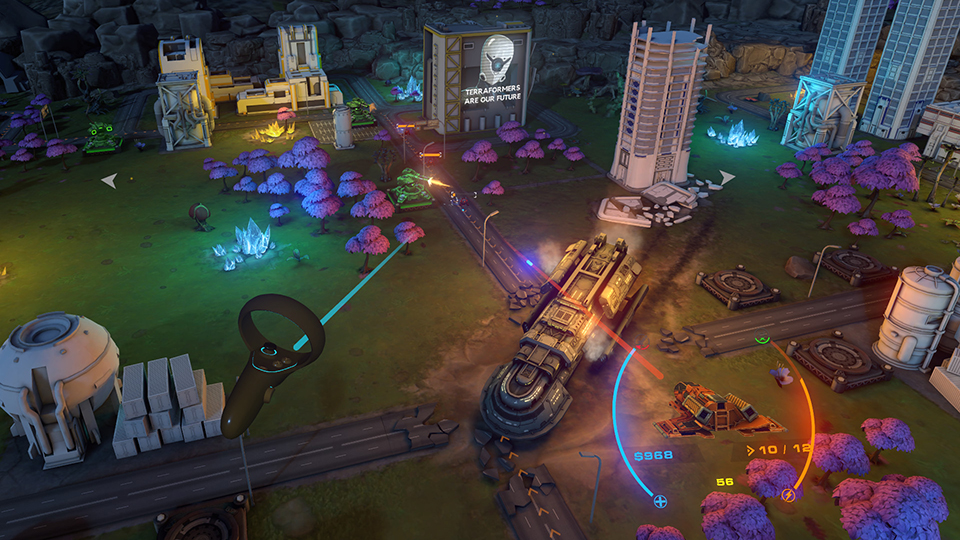 The meat of Iron Guard is a 30-mission campaign that, depending on your skill, should take you anywhere from 7-10 hours to complete. The core gameplay here is wave-based with a rest period in between, giving you time to develop your defense strategy. Enemies attack along designated paths that switch up between waves. This allows you to focus on individual paths for a few rounds and, to not only build defenses, but also test to see if they will hold before the game introduces multiple paths attacking simultaneously. This was an approach I really appreciated as it kept the early moments more strategic and experimental instead of simply stressful. Further to this, upon death, the order in which paths will attack is mixed up. This keeps you on your toes and avoids the irritation of repeating the exact same situation over and over, while still maintaining the various strategies you might be developing through a trial and error method.
The meat of Iron Guard is a 30-mission campaign that, depending on your skill, should take you anywhere from 7-10 hours to complete. The core gameplay here is wave-based with a rest period in between, giving you time to develop your defense strategy. Enemies attack along designated paths that switch up between waves. This allows you to focus on individual paths for a few rounds and, to not only build defenses, but also test to see if they will hold before the game introduces multiple paths attacking simultaneously. This was an approach I really appreciated as it kept the early moments more strategic and experimental instead of simply stressful. Further to this, upon death, the order in which paths will attack is mixed up. This keeps you on your toes and avoids the irritation of repeating the exact same situation over and over, while still maintaining the various strategies you might be developing through a trial and error method.
Early missions arm you with a simple combo of a machine gun turret and an electric turret that slows down enemy movements, the former of which can be upgraded on the fly to attack harder. In addition to your deployable units, your right hand also holds a ship which has a basic laser blast to assist where needed. I found this very helpful when testing an attack path out and cleaning up the few that got through on a failed blockade. The enemy fleet consists of a few different drones, with some being fast but fragile and others being slow and heavy, with a few variations in between.
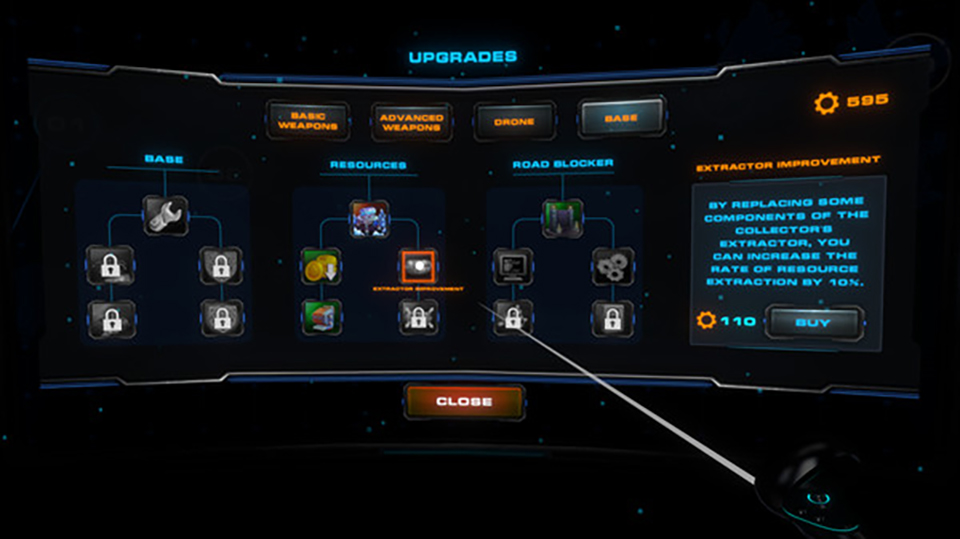 Early strategy here is learning what to do with not just the different types of units, but more importantly what to do when they are grouped in different combinations. For example, early on I found that my turrets would focus on and take down heavy enemy drones quite easily, but would let the fast drones zip past and take out the base I was protecting. So my choice and placement of different combinations of turrets to deal with the variety in the enemy bots was something I had to quickly consider. The build model for defense in the game is currency based, with each unit you place costing a specific amount with an additional expense for upgrading where possible.
Early strategy here is learning what to do with not just the different types of units, but more importantly what to do when they are grouped in different combinations. For example, early on I found that my turrets would focus on and take down heavy enemy drones quite easily, but would let the fast drones zip past and take out the base I was protecting. So my choice and placement of different combinations of turrets to deal with the variety in the enemy bots was something I had to quickly consider. The build model for defense in the game is currency based, with each unit you place costing a specific amount with an additional expense for upgrading where possible.
Later in the game a simple harvesting mechanic is brought in. By placing a harvester over resources, additional revenue can be generated during missions. Enemy units do not attack your placed units, meaning you can place and essentially forget them. While this could have added more depth to the gameplay, the developer seems to have found a nice balance between giving you enough action to focus on (the multiple paths of enemy attacks) and giving you enough time to sit back and just see if your plan is working and assess. I found this preferable to constantly zipping around fixing crumbling units as I have done in other tower defense games.
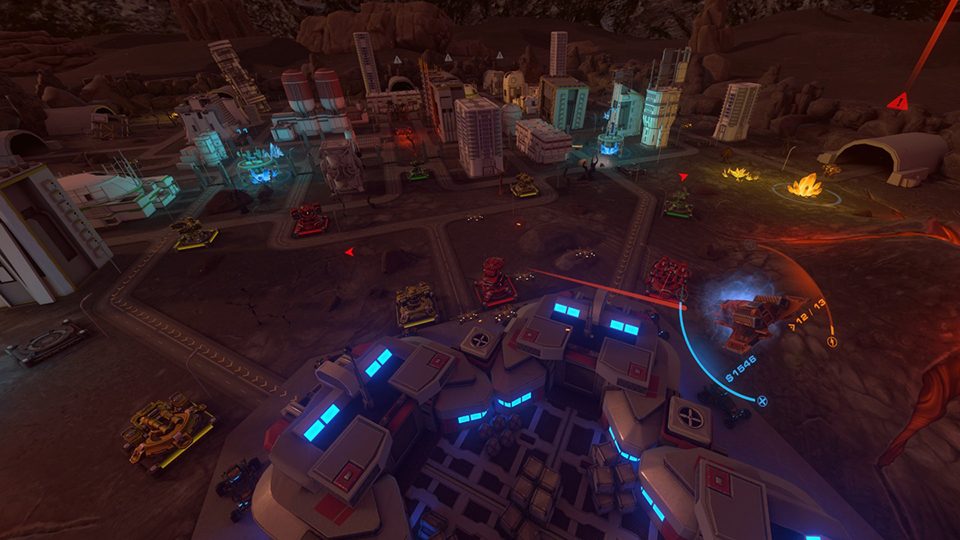 This style choice can be evidenced again by how free flying drones will go after you, never attacking your base but instead draining your ship’s energy level, impairing your ability to shoot and deploy air strikes. Rocket turrets can take these free flying drones down, but this also distracts them from other tasks. So, you have to decide for yourself how best to deal with them.
This style choice can be evidenced again by how free flying drones will go after you, never attacking your base but instead draining your ship’s energy level, impairing your ability to shoot and deploy air strikes. Rocket turrets can take these free flying drones down, but this also distracts them from other tasks. So, you have to decide for yourself how best to deal with them.
While gameplay starts off simple, thankfully the game is consistently introducing new enemy types, new map layouts, level biomes and, most importantly, new weapons for you to play with. Some weapons will be given to you during a mission, but many will require unlocking through the use of earned skill points. The amount of skill points earned is primarily based on mission performance, but they can also be picked up from downed enemies during missions.
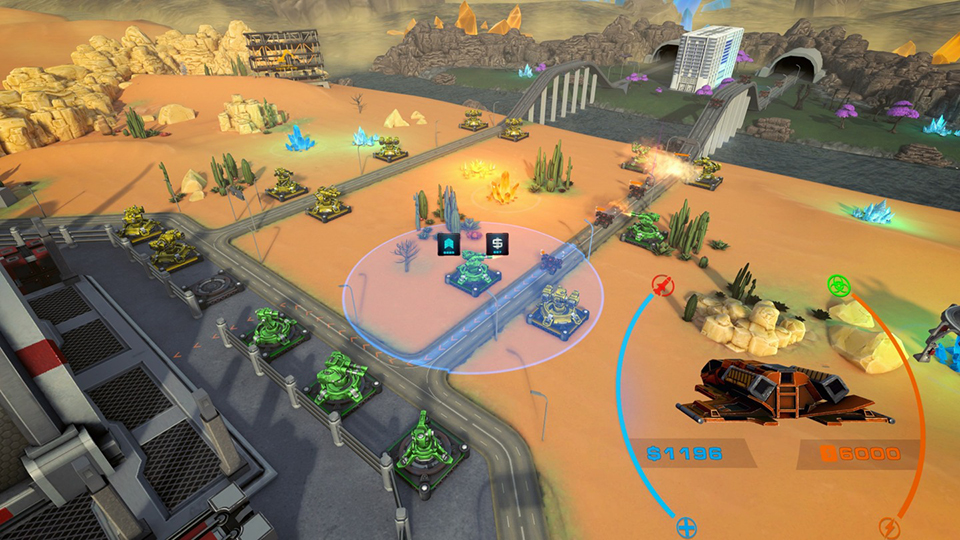 I love a good progression system in my games and Iron Guard did not disappoint in its offerings. There was enough choice in weaponry for me to pick up and prioritize for my own attack styles. Weapons on offer vary from rocket, fire, and laser turrets (all of which can be further upgraded); weapon upgrades to your handheld ship and defensive base; as well as an assortment of power air strike attacks that power up during battle and can be unleashed in dire moments of need. Another aspect of the progression system I liked was the ability to go back and improve on a previous mission score to earn more experience points and, as a result, buy better gear. This was especially helpful when I found myself getting my ass kicked during a mission. Luckily the game does this in a way that feels like a choice and never simply a make-work task to grind out game length.
I love a good progression system in my games and Iron Guard did not disappoint in its offerings. There was enough choice in weaponry for me to pick up and prioritize for my own attack styles. Weapons on offer vary from rocket, fire, and laser turrets (all of which can be further upgraded); weapon upgrades to your handheld ship and defensive base; as well as an assortment of power air strike attacks that power up during battle and can be unleashed in dire moments of need. Another aspect of the progression system I liked was the ability to go back and improve on a previous mission score to earn more experience points and, as a result, buy better gear. This was especially helpful when I found myself getting my ass kicked during a mission. Luckily the game does this in a way that feels like a choice and never simply a make-work task to grind out game length.
One area where the game does fall a little short is mission variety. There are 30 missions to complete, all of which do an incredible job of mixing up attack path styles in ways that actually affect gameplay. However, missions are all essentially wave-based, protect-the-base missions. The story tries to give some meaning to these, and the game does try to mix things up with added variety to the waves. Regardless, you are still just placing units and holding the line until a given amount of time has passed, waves complete, or money has been earned. As such, as hard as the game tries to introduce ideas throughout the campaign, it does begin to get a bit “samey”, especially if you do too many missions in a row. Be that as it may, Iron Guard knows what it is and doesn’t try to hide that fact. It does a great job of nailing the core gameplay essentials of a tower defense game.
There are both teleport and “smooth turning” options in the game (although the smooth turning acted more like click-turning). I often found myself physically turning around in my chair. The Quest version has high controls which are unfortunately only available in the settings menu and not adjustable while in-game. This option was not present in the PC version, which will hopefully get patched in the future.
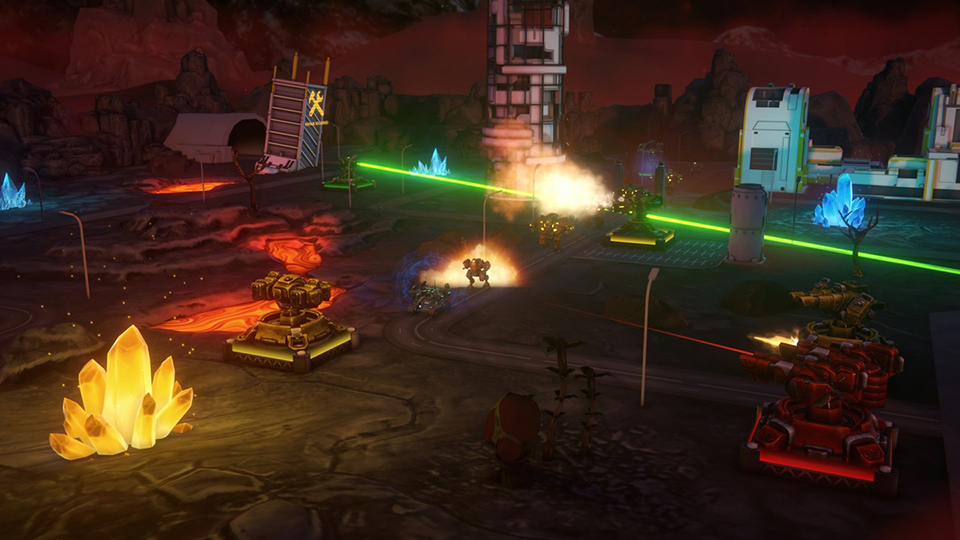 At a quick glance, both the Quest 2 and PCVR versions look very similar and they are. The quality of visuals is comparable to how Demeo on Quest 2 looks when compared to the PCVR version. What I mean by this is that the Quest 2 version looks absolutely fine when playing inside the headset: objects are sharp enough and the headset handles the high action moments flawlessly. However, when jumping into the PC version you realize how many effects and texture details had been removed for the port to the Quest. Weather effects, more advanced lighting systems, and a much sharper overall image make the PC version the version to get if you have the option. It was simply a prettier experience. Quest users, you are getting essentially the same game though. It’s an “if you don’t see it you likely won’t miss it” situation. Iron Guard is not a visual feast regardless of platform, but it has enough world and unit detail to keep the world interesting enough to play inside.
At a quick glance, both the Quest 2 and PCVR versions look very similar and they are. The quality of visuals is comparable to how Demeo on Quest 2 looks when compared to the PCVR version. What I mean by this is that the Quest 2 version looks absolutely fine when playing inside the headset: objects are sharp enough and the headset handles the high action moments flawlessly. However, when jumping into the PC version you realize how many effects and texture details had been removed for the port to the Quest. Weather effects, more advanced lighting systems, and a much sharper overall image make the PC version the version to get if you have the option. It was simply a prettier experience. Quest users, you are getting essentially the same game though. It’s an “if you don’t see it you likely won’t miss it” situation. Iron Guard is not a visual feast regardless of platform, but it has enough world and unit detail to keep the world interesting enough to play inside.
The game sounds…well, it sounds like what you might expect a game of this genre to sound like. Weapon sounds are serviceable, but nothing special. It can drone on a bit when you have 30 turrets going off all at once. What hurts the sound quality is that the game lacks any real 3D audio. So the gun sounds stay pretty consistent in volume with the exception of some drop off at a distance. Voice acting is serviceable- even hitting above average – and never grating too much while delivering the rather paint-by-numbers story you likely won’t care about.
I have to laugh about the music though, as it’s the generic 90’s hard rock you might have heard in countless games from that era. But I will admit to bobbing my head to the chug-chug-chug guitar riffage. I do wish there was more variety to the tracks though, as they got old after a while. Regardless, I recommend you turn the music down a bit in the mix and put it in the background.
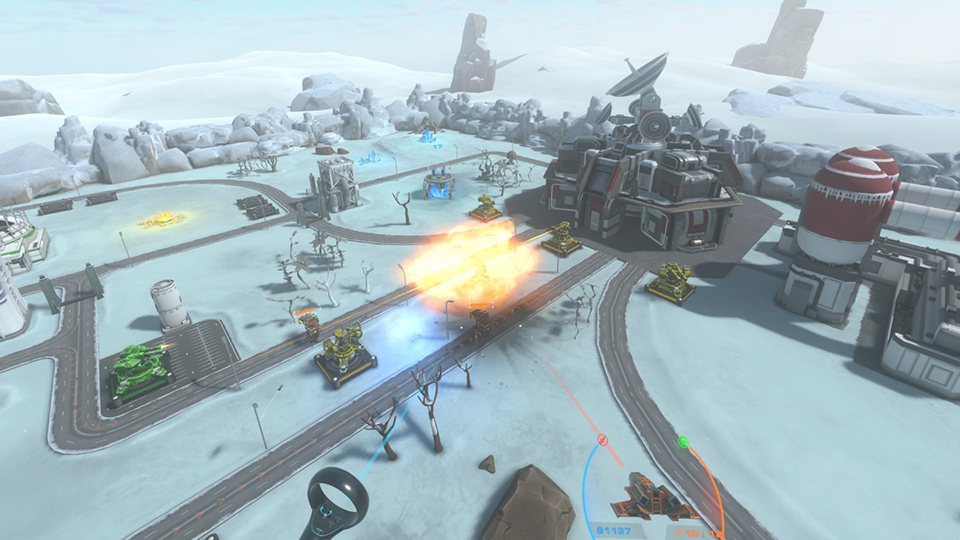 I love a good tower defense game, and, like RTS games, this genre works really well in VR as you can spread the whole battlefield out in front of you like a kid with a playset. Iron Guard is fairly meat and potatoes, with an addictive progression system, well-balanced combat, and enough content to keep you shooting for a good 8 hours of single player gameplay. Co-op and additional difficulty settings would provide for additional replay value, but this remains a fun time for those who appreciate these types of games regardless. Tower defense games are far and few between for VR and Iron Guard stands as one of the best to date as it sticks to the formula, throws in a few neat ideas, and keeps it fun.
I love a good tower defense game, and, like RTS games, this genre works really well in VR as you can spread the whole battlefield out in front of you like a kid with a playset. Iron Guard is fairly meat and potatoes, with an addictive progression system, well-balanced combat, and enough content to keep you shooting for a good 8 hours of single player gameplay. Co-op and additional difficulty settings would provide for additional replay value, but this remains a fun time for those who appreciate these types of games regardless. Tower defense games are far and few between for VR and Iron Guard stands as one of the best to date as it sticks to the formula, throws in a few neat ideas, and keeps it fun.
Xlab Digital LLC provided The VR Grid with codes for this review and, regardless of this review, we thank them for that!




